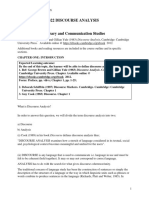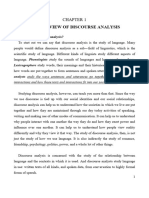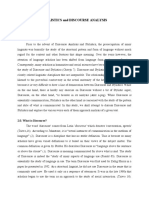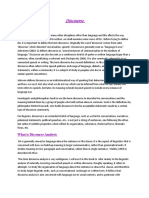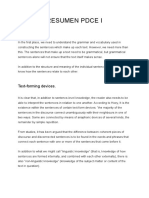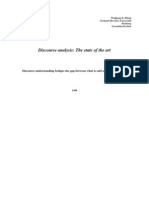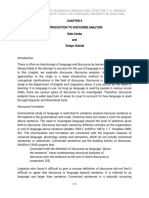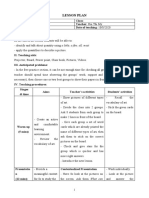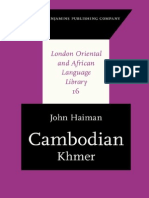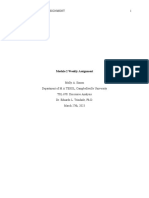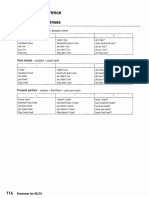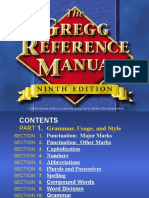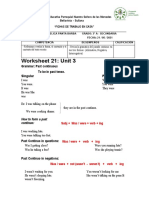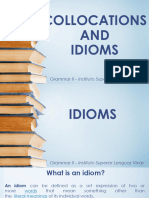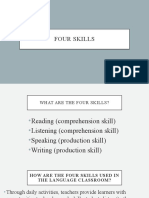Overview of Discourse Analysis
Uploaded by
Rocio Vazquez CadenaOverview of Discourse Analysis
Uploaded by
Rocio Vazquez CadenaII.
REVIEW OF RELATED LITERATURE
2.1 AN OVERVIEW OF DISCOURSE ANALYSIS
2.1.1 The Definition of Discourse Analysis
In the study of language, some of the most interesting questions arise in
connection with the way language is ‘used’, rather than what its components are.
We were, in effect, asking how is that language-users interpret what other
language-users intend to convey. When we carry this investigation further and ask
how is that we, as language-users, make sense of what we read in texts,
understand what as opposed to jumbled or incoherent discourse, and successfully
take part in that complex activity called conversation, we are undertaking what is
known as discourse analysis.
The analysis of discourse is necessarily, the analysis of language in use.
As such, it cannot be restricted to the description of linguistic forms
independently to the purposes or functions which those forms are designed to
serve in human affairs. While some linguists may concentrate on determining the
formal properties of a language is used for. While the formal approach has a long
tradition, manifested in innumerable volumes of grammar, the functional
approach is less well documented. Attempts to provide even a general set of labels
for principal functions of language have resulted in vague, and often confusing,
terminology.
The term discourse analysis is very ambiguous. It can refer to the
linguistic analysis of naturally occurring connected spoken or written discourse.
Universitas Sumatera Utara
Roughly speaking, it refers to the attempts to study the organization of language
above the sentence or above the clause, and therefore to study larger linguistics
units, such as conversational exchanges or written texts. It follows that discourse
analysis is also concerned with language in use in social contexts, and in
particular interaction or dialogue between speakers.
Discourse analysis is concerned with the study of the relationship
between language and the context in which it is used. It grew out of work in
different disciplines in the 1960s and early 1970s, including linguistics, semiotics,
psychology, anthropology and sociology. Discourse analyst study language in
used; written texts of all kinds and spoken data from conversation to highly
institutionalized forms of talk.
2.1.2 The Scope of Discourse Analysis
Discourse analysis is not only concerned with the description and
analysis of spoken interaction. In addition to all our verbal encounters we daily
consume hundreds of written and printed words: newspaper articles, letters,
stories, recipes, instructions, notices, comics, billboards leaflets pushed through
the door, and so on. We usually expect them to be coherent, meaningful
communications in which the words and/or sentences are linked to one another in
a fashion that corresponds to conventional formulae, just as we do with speech;
therefore discourse analysts are equally interested in the organization of written
interaction.
Universitas Sumatera Utara
2.1.3 The Types of Discourse
Discourse can be classified into two kinds, namely:
1) Oral Discourse or Spoken Discourse
It is a discourse which used the spoken text, such as conversation. By
oral discourse, we mean discourse which text is constructed in the real
time. It means oral discourse is concerning some actual facts in the
present time.
2) Written Discourse
It was formed by the written text (written language). By written
discourse, we mean discourse which text is not constructed in the real
time.
Briefly, these two types of discourse above can be distinguished according to the
type of situation. Oral discourse is concerning face-to-face situation while a
recorded transmission situation involves in the written discourse.
There are still other types of discourse which is important to be
distinguished namely interactive and non-interactive discourse. A definition of
interaction, if it is to be used for the term of discourse, should be based on an
analysis on the type of role play by participants in the communication. It is called
interactive discourse if each participant constructs only part of text, expressing a
number of fragments in alternation with the other participants. It is called non-
interactive discourse if a single participant is responsible for the whole of the
discourse.
Universitas Sumatera Utara
Can both the oral and written discourse be both interactive and non-
interactive? It is undutiful that the majority of oral discourse is interactive, since
this type of discourse is usually realized in face-to-face communicative situation
which generally need the interactive participation of all present. In certain
situation, however, the oral discourse can be in non-interactive form, for example
the political speech or lecturer, who is clarifying the subject of the lesson,
produces the whole discourse orally by him without any participation of the
collegian.
On the other hand, a written discourse can also be interactive and
continuity. For example: in the first letter, Bob writes to his uncle asking for help.
In the second letter, Bob’s uncle replies the help will be given at the exact time he
needs. In the third letter, Bob thanks his uncle for the favor that was offered, and
mentions the time when he needs the help. These three kinds of letters are
regarded as three ‘speaking turns’ which form the whole. This discourse is,
therefore, interactively coherent.
2.1.4. Properties of Discourse
There are 3 properties of discourse, they are discourse forms structures,
conveys meaning, and accomplishes action. The first two properties are largely
concerned with discourse as extended sequences of smaller units, e.g. sentence,
propositions and utterances. The third property is more concerned with language
as it is used within social interaction; included is speakers’ use not only of
extended sequences, but their use of single unit within social interaction.
Universitas Sumatera Utara
1. Structure
More recent approaches have based discourse grammars on
transformational generative sentence grammar claims that texts can be treated as
extensions of sentences and that a text grammar can be written in the same form
as a generative sentence grammar. Within such a text grammar, the acceptability
of a discourse would be determined by a set of rules acting as formal criteria for
the interpretability of sentences within the text. Several studies take a more liberal
approach to non-textual factors in their suggestion that discourse structure reflects
the informational content and structure what is being talked about. They all view
discourse as a structured composition of linguistic constituents (morphemes,
clauses, sentences) within a monologue.
2. Meaning
Particular items such as pronouns, adverbs and conjunctions help create
discourse not because of their rule-governed distribution, but because they
indicate an interpretive link between two parts within the text. And although we
can recognize a cohesive element by its surface appearance in a clause, what such
an element actually display is a connection between the underlying propositional
content of two clauses - the clause in which the element appears and a prior
clause. In short, the cohesive link is established because interpretation of an
element in one clause presupposes information from a prior clause.
Studies of cohesion indicate that the meaning conveyed by a text is
meaning which is interpreted by speakers and hearers based on their inferences
about the propositional connection underlying what are said. Cohesive devices do
Universitas Sumatera Utara
not themselves create meaning; they are clues used by speakers and hearers to
find the meanings which underlie surface utterances.
3. Actions
Structure and meaning are properties of discourse when discourse is
considered as a linear sequence of smaller units, e.g. sentences, turns,
propositions. Although action or more accurately the accomplishment of action is
also a property of discourse, it is a property which emerges not so much from
arrangements of underlying units, as from the organization of speaker goals and
intentions which are taken up and acted upon by hearers, and from the ways in
which language is used in service of such goals.
2.2 DISCOURSE MARKERS
2.2.1 Why Analyze Discourse Markers
The analysis of discourse markers is a part of more general analysis of
discourse coherence-how speaker and hearer jointly integrate forms, meanings
and actions to make overall sense out of what is said.
For example, the discourse (1) is a rhetorical argument through which a
speaker (Tina) is defending a position-her belief in destiny-by presenting personal
experience to serve as evidence, or support, for that position.
(1) a. I suppose we can’t deny that we all have our own time in this world.
b I believe that … y’know its destiny.
c. it really is.
d. because my grandfather died of heart-attack.
e. and one day before that he instead to have a great party.
Universitas Sumatera Utara
f. and I really believe.
g. I don’t think that you can deny destiny.
f. and I think a lot of people do.
g. I don’t think that you can deny destiny.
h. and I think a lot of people do.
i. but I feel that we are brought to this world for many, years or whatever the
case is
j. and that’s how it was and it will be.
k. because like when I was studying in Malaysia
l. I supposed to study there for two years.
m. I got a letter saying that my immigration files got lost.
n. and I had to go back to Indonesia.
o. And when I got back I got admitted in USU, Indonesia.
p. while I was enjoying my stay in Malaysia.
q. and I just felt, this was better for me.
r. because if it isn’t, I would have not got into USU.
s. so eh y’know it seems it just seems that it’s meant to happen like that.
Consider, first, that (1) forms an argument because it contains two
informational differentiated parts. The main part of an argument as a position: a
general statement toward whose truth a speaker is committed. Subordinate to the
position is support: any information, e.g. personal experience, other’s testimony,
logical reasoning, which justifies either the truth of the statement of the speaker’s
commitment towards the truth. Ira’s position in (1) is that she believes in destiny;
Universitas Sumatera Utara
she states this in various ways in several locations; lines (a)-(c), (f)-(j) and (s),
support for this position is given through brief description of two experiences in
which coincident events had no rational explanation, and are thus interpreted as
meant to be. This evidence is presented (in line d-e, k-r) between paraphrases of
the position.
Several markers in (1) play a role in its formation as an argument. First,
we find because preceding support in (d) and (k). Because often precedes not just
evidence, but other casually related discourse material, e.g. background
information in narratives.
We find and in (f); and precedes a self-interrupted restatement of the
position. We will see that and often precedes material which continues an earlier
part of discourse-especially material which is not subordinate to the overall
structure of the discourse. In both (h) and (j), and links ideas which seems closely
related to just prior ideas. In (h), the speaker is contrasting a feeling of her own
(about denying destiny) with the actions of others. Thus, within the position, and
seems to have a role in linking related ideas when the union of those ideas play a
role in larger ideational structure of the argument.
In (i) but is an adversative conjunction suggests that what follows but is
an idea which contrasts with what has preceded. Like and, then, it seems that but
could have a cohesive function within the position.
Finally we find so in (s), preceding the final paraphrase of the position.
We will see often so brings information understood as resultative (the outcome of
connection between reported events) or conclusive (the outcome of inferential
connections). Markers also occur within the position and the support.
Universitas Sumatera Utara
There is one other marker in (1) that is y’know. It is directed toward
gaining hearer involvement in an interaction. In (b) and (s), y’know seems to be
marking some kind of appeal from speaker to hearer for consensus, e.g. for
understanding as to the meaning of destiny, or even for understanding as to the
meaning of destiny, or even for agreement on the position being taken about
destiny.
We will see that y’know is widely used throughout talk at locations in
which discourse tasks hinge on special cooperative effort between speaker and
hearer.
The observation about what markers add to discourse have based largely
on their locations within discourse where markers occur, and with what markers
co-occur. There are other issue: markers as coherence options, shows options for
each other-as alternative ways of saying the same thing also rises the problem of
whether elements as diverse as and, y’know can form one class of items in a
discourse paradigms. In traditional linguistic analysis, items which occur in the
same environment but do not produce a different meaning are in contrast, whereas
items which occur in the same environment but do not produce a different in
meaning are in free variation.
2.2.2 Kinds of Discourse Markers
As explained above, there are many kinds of discourse markers.
Understanding of discourse markers requires separating the contribution made by
the marker itself, from the contribution made by the discourse slot in which the
markers occur.
Universitas Sumatera Utara
1) Marker of Information Management
The first type of discourse markers is oh. The explanation of discourse
markers oh is not clearly based on semantic meaning or grammatical status.
Oh is traditionally viewed as an exclamation of interjection. When it use
alone, without the syntactic support of a sentence, oh is said to indicate strong
emotional states, e.g. surprise, fear or pain. For examples:
(1) Andi : Was that interesting games?
Budi : oh ! yes! It was
(2) Andi : Like I’d say, ‘What d’y’mean you don’t like rock music concert?
Oh! I don’t like it. It’s too crowded
Oh can aslso initiate utterances, either followed by a brief pause;
(3) Fay : oh, well I was here when I was a child
Or with no pause preceding the rest of tone unit:
(4) Adi : does he like classical music? Oh maybe he’s too young.
Regardless of its syntactic status on intentional contour, that oh occurs
as speaker shift their orientation to information. Oh pulls the flow of information
in discourse to the temporary focus of attention which is the target of self and or
other management. Oh occurs in several different situations such as: oh in repair
initiation, for example, Cathy is answering a question about whether she believes
in extrasensory perception by describing her husband Jack’s abilities to predict
future political events.
(5) I mean …he can almost foresee:…eh::for instance with
Nixon…he said …now he’s not in a medical field my husband.
He said coagulation his blood…uh thinning his-Nixon‘s blood…will
Universitas Sumatera Utara
not be good for him, if he should be operated on. Oh maybe it’s just
knowledge.
I don’t know if that’s E.S.P or not in that C-in this case.
Cathy recategorizes a particular description from an instance of E.S.P. to
an instance of knowledge: this self-repair is initiated with oh.
Oh prefaces both self and other completion. For example, Lita self-
initiates and self completes her replacement of yeh with no and Senior High
School Plus and then further self-completes with oh that’s right.
From all the examples above, oh has a role in information status because
oh marks a focus of speaker’s attention which then also becomes a candidate for
hearer’s attention. Oh has or is suggested to have a pragmatic effect-the creation
of a joint focus. Oh can be focused on or situated in social interaction. First, oh
makes evident a very general and pervasive property of participant framework.
Because oh displays one’s own on going management of information, its user is
temporarily displayed as an individual active in the role of utterance reception.
So oh is a marker of information management: it marks shifts in
speaker’s orientation (objective and subjective) to information which occurs as
speakers and hearers manage the flow of information produced and received
during discourse. Orientation shifts affect the overall information of state of a
conversation: the distribution of knowledge about entities, events, and situations.
Although oh is a number of cognitive tasks, its use may have pragmatic effects in
interaction.
Universitas Sumatera Utara
2) Marker of Response
Like oh, the use of well is not based on semantic meaning or
grammatical status. Although well sometimes is a noun, an adverb or degree
word, its use in utterance initial position is difficult to characterize in terms based
on any of these classes. We can see some placements of well.
It can occur in request-compliance pairs, for example: in (1) Irene issues
a request for action to Henry and Zelda, who have been talking about topics other
than those on conversational agenda.
(1) Irene : Let’s get back because she’ll never get home.
Debby : Well, actually we don’t have that much more.
Well can occur in request for confirmation although it is a bit harder to
identity. Such requests are often identifiable because of the information status
assumed to hold at the time of speaking, that is, speaker or hearer knowledge and
meta-knowledge. This is, if a speaker makes a statement about an event about
which a hearer is expected to have knowledge as request for confirmation, then,
are statements about the hearer’s past life, abilities, likes and dislikes, knowledge,
and so on. For examples:
(2) Erwin : And my father has been working for the government company.
Roni : So your father must like them as an employer then.
Erwin : Well my father likes his job, now.
Well is a response marker: well anchors its user in a conversational
exchange when the options offered through a prior utterance for the coherence of
an upcoming response it is not precisely followed. More generally, well is
possible whenever the coherence options offered by one components of talk differ
Universitas Sumatera Utara
from another: well locates a speaker as a respondent to one level of discourse and
allows a temporary release from attention to others.
3) Markers of Connectives
Another different set of markers are and, but, and or. They are called
discourse connective. The first item of this kind of marker is and. And is the most
frequently used mode of connection at a local of idea structure, for examples:
(3) a. See this is what every student does.
b. But we were serious
c. And we tried to answer
d. And we tried to pass
e. And we fail
Mathematic teacher is explaining that every student tried to do the sum
in the exam (a,c,d); some students, however, failed the exam (b, e). The contrast
between the efforts to pass and the unintended fail is marked, first with but (in b),
and then with and (in e). And thus occurs in environment by but.
And also occurs in an environment shard by so. In (4) Nely prefaces and
outcome of reason with and. She is explaining why she remembers a particular
childhood game; note, again preface of the reason with because.
(4) a. That’s one game I remember
b. Because we had a driveway
c. And, like we would hide
d. And they would walk around the driveway?
e. Y’know?
f. And I- I remember it so distinctly
Universitas Sumatera Utara
After explaining why she remembers the game (b-c), Nely again
mentions that memory (f). Her paraphrase of the outcome is prefaced with and
rather so.
And is a structural coordinator of ideas as which has pragmatic effect as
a marker of speaker continuation. But discovering which ideas are coordinated by
and, which action are continued, required looking into the content and structure
which tell us what idea units, are being marked by and.
The second item of connective marker is but. Although but is a discourse
coordinator (like and), it has a very pragmatic effect: but marks an upcoming unit
as a contrasting action, because this effect is based on its contrastive meaning, the
range of ideational uses of but is considerably narrower that that of and, for
examples:
(5) a. But, in my house, we were not taught liar.
b. And he didn’t have a place to sleep.
c. Never did I ever say this girl is like this, that girl is like that.
d. It was prove for a fact that her uncle always did take care of his
children.
e. She put her in her own house.
f. So we were not liar.
This shows the contrast that becomes a new position, and evidence is
presented to support his position. In (6), John shows or faced contrast with the
tolerance provided the family.
(6) g. But, I went to my village.
h. And I-I felt the hostility in some people
Universitas Sumatera Utara
This contrast explains the use of but in (g). The mentioning of hostility
is also broader structural role in the argument: it provides an instance of support,
and thus provides evidence for the main position of the argument. But marks both
position and support in John’s argument. But it does so only when the content of
those units contrast with prior ideas: but in (a) contrast the tolerance faced by one
group with the tolerance provided by that group; but in (g) marks both of these
contrasts. But marks idea units which are functionally related-support, position,
their functional relationship is less important than their contrastive contents in
explaining the use of but.
The third item of connective marker is or. Or is used as an option marker
in discourse. It differs from and and but not only in meaning, because it is move
hearer-directed: whereas and marks a speaker’s continuation, and but a speaker’s
return to a point, or marks a speaker’s provision of options to hearer. Or offers
accepting only one member of disjunc or both members of a disjunct. Or provides
idea options in argument-a mode of discourse whose organization has also
revealed the use of and and but. Or is used in arguments primarily to mark
different pieces of support as multiple evidence for a position. In (7), for example,
Jack is arguing Hongkong movies never present a realistic view of life. He
presents two examples to support his generalization about the lack of realism.
(7) Jack : i. I’m-I’m speaking how kind everybody is on the movie.
j. Or uh …how’s poor working girl is out looking for a job.
There are two potential ways to interpret or in (7). First, we could say
Jack is directing his hearers to choose one example, either example, but only one.
This would mean that or is exlusive: only one member of the disjunct can hold.
Universitas Sumatera Utara
This would mean that or is inclusive; either one member or both members of the
disjunct can hold.
Or is also used to offer inclusive options, as a response to questions, for
examples:
Ita : a. I’d like t’live in Jakarta.
Wina : b. Who wouldn’t
Ita : c. I was up there with my husband last two weeks. There are
many beautiful places there.
Wina : d. There are really beautiful.
Ita : e. Or I have a sister that lives up in eh: Bandung. Do you know
it?
Wina : f. No. I’ve never gone there.
Ita : f. So, they have nice places, really beautiful places
Or can also occur in a clarification. For examples:
Edy : a. If I had a girl friend
b.I’d never let her go out to somewhere alone.
Evi : c. Y’think it’s too uh…
Edy : d. I would never let her t-
e. No no no. Its very good idea
f. But I or I would never let my sister to go out to somewhere
alone either
g. I think its too-it’s too dangerous for them.
h. I think that they should be with their friends.
Universitas Sumatera Utara
Or is also used in offering inclusive options to hearer in disagreement.
For example:
Diana : a. Yeh, but wait; it doesn’t mean because they’re got the same
religion, they’re-they’re bad.
b. Or if they are of your religion that things are gonna work out
well.
c. It’s the person… too.
d. So it takes both.
Or is used as an option for a marker in discourse: it provides with a
choice between accepting only one member of disjunct or both members of
disjunct. Thus, or is fundamentally different from and and but because it is not a
marker of a speaker’s action toward his own talk, but of a speaker’s desire for a
hearer to take action.
More specifically, or represents a speaker’s effort to elicit from a hearer
a stance toward an ideas unit, or to gain a response of some kind, or thus prompts
the exchange the status quo, and but returns it to a prior state.
4) Markers of Cause and Result
Another different set of markers are so and because. They are called
markers of cause and result. Like and, but, and or, so and because have
grammatical properties which contribute to their discourse use. So and because
are grammatical signals of main or subordinate clauses respectively, and this
grammatical difference is reflected in their discourse use: because is a marker of
subordinate idea units, and so is a complementary marker of main idea units. It is
important to define ‘subordinate’ and ‘main’ in discourse. Such designations
Universitas Sumatera Utara
depend on both the functional and referential organization of talk. From a
functional perspective, subordinate material is that which has a secondary role in
relation to a more encompassing focus of joint attention and activity. From a
referential perspective, subordinate material is that which is not as relevant in and
of it, as it is to a more global topic of talk. For example, so and because may show
a fairly clear differentiation of main by from subordinate material. In the
following examples, Defy is explaining why she and Fajar are not going to see
their daughter that evening.
Defy : a. Well, we were going up t’see uh…my- our daughter tonight.
b. But we’re not
c. Cause the younger one’s gonna come for dinner.
d. Cause he’s working in the neighborhood.
e. So that’s out.
The event being explained is in (b): we’re not. The first reason is in (c)
and a reason for that reason is in (d). Thus, Defy uses cause to progressively
embedded reason in her explanation.
Because and so have semantic meaning which are realized at both
sentence and discourse levels: because conveys a meaning of ‘cause’ and so
conveys meaning a ‘result’. These meanings appear on three of planes of
discourse: ideational structure, information state and actions.
Because and so can mark fact-based cause and result relations at both
local and global levels of discourse. (1) Illustrates so at both levels.
(1) a. So, her mother wouldn’t let her go to there anymore.
b. And she tried to get another jobs and she couldn’t
Universitas Sumatera Utara
The event in (a) resulted from the prior story events; thus, so functions
globally over a wide range of talk.
Both because and so are use used to mark convergent portions of an
explanation and an answer. For examples:
Ira : a. Susi goes with me a lot
b. Cause she has more patience…with my son I do
c. So, sometimes we go shopping together with my son.
It is important to note down that so is used at potential transition
locations in talk-when speakers offer hearer a turn at talk, a chance to complete an
incomplete proposition by answering a question, an opportunity to change topic.
Because and so convey meanings of cause and result which may be
realized as fact-based, knowledge-based and/or action based relations between
units of talk. Like the other markers considered so far, so and because work at
both local and global levels of talk. At local level, so and because allow two
ordering options which are thematically constrained by surrounding discourse.
Like and, but, and or, so and because are used in discourse in ways which reflect
their linguistic properties.
5) Markers of Temporal: Now and Then
Deictic elements relate an utterance to its person, space and time
coordinates. Now and then are time deictics because they convey a relationship
between time at which a proposition is assumed to be true and the time at which it
is presented in an utterance. In other words, now and then are deictic because their
meaning depends on a parameter of the speech situation (time of speaking).
Universitas Sumatera Utara
Now occurs in discourse in which the speaker progresses through a
cumulative series of subordinate unit. The discourse in which now occurs need
not be explicitly structured or identified as having two subordinate units. Now
occurs not only when the comparison is explicitly identified as having two clearly
introduced subtopics, but also when the subtopics under comparison are only
implicit. For example:
Tony: a. They aren’t brought up the same way.
b.Now Italian people are very outgoing.
c. They’re very generous.
d.When they put a meal on the table it’s a meal.
e. Now, these boys were Irish.
f. They lived different.
Tony is comparing the childbearing practices of Italians and Irish. This
comparison is explicitly introduced in (a). Following the introduction of the
comparison, Tony uses now to introduce both subtopics: Italians (b) and Irish (e).
Now also occurs with an opinion about a disputable topic. It is
displaying the speaker’s recognition of interpersonal differences about that topic.
For example: Sally has asked Zelda how she feels about intermarriage.
a. Well …it is all depend on um..
b. Now my husband believes in eh marrying in his own religion.
c. And he tried to stress it with the boys.
After introducing a comparison (a), Zelda prefaces her husband Henry’s
position with now. She then continues with her own opinion.
Universitas Sumatera Utara
Now shows a speaker’s progression through the discourse time of a
comparison a discourse which is comprised of a cumulative series of subtopic. In
all the comparisons, however, now has the same function. It displays that what is
coming next in the discourse is but a subpart of a larger cumulative structure, and
thus has to be interpreted as a subordinate unit in relation to a progression of such
units. In short, now marks the speaker’s orderly progression in discourse time
through a sequence of subparts.
Then indicates temporal succession between prior and upcoming talk.
For example: Sari is answering Tina’s question about where she has lived:
a. And…I lived there until I got married.
b. And then, for about two years after then
c. So: uh, and then we moved here.
d. We’ve been living here for about twelve years.
In (b), then indicates both coterminous and successive event time: initial
then marks the two years time period following Sari’s marriage (a) and final then
marks the time period co-occurring with the time of the marriage.
Then marks successive subtopics in list. For example: Irene is answering
Lely’s questions about her bowling team.
Lely : How many people are in the team?
Irene : Four
Lely : So, it’s just the two of you and …
Irene : The two couples, yeh…
And then the kids have their own team.
Universitas Sumatera Utara
The overall topic of Irene’s answer is the membership of the bowling
teams. Her two subtopics are the members of each team: first, the two couples and
second, the kids. Her answer lists the two teams.
Then indicates temporal succession between prior and upcoming talk.
Its main difference from now is the direction of the discourse which it marks: now
points forward in discourse time and then points backward. Another difference is
that now focuses on how the speaker’s own discourse follows the speaker’s own
prior talk; then, on the other hand, focuses on how the speaker’s discourse follows
either party’s prior talk.
6) Markers of Information and Participation
The last markers whose literal meanings directly influence their
discourse use are y’know and I mean. Y’know marks transition in information state
are relevant for participant framework, and I mean marks speakers orientation
toward own talk i.e. modification of idea and intention. Both markers also have
the uses which are less directly related to their literal meanings: y’know gains
attention from the hearer to open an interactive focus on speaker-provided
information and I mean maintains attention on the speaker. These both markers
are called information and participant.
Y’know functions as the first information and participant marker. The
literal meaning of expression you know suggests the function of y’know in
information status. You is a second pronoun and it is also used as an indefinite
general pronoun similar to one. Know refers to the cognitive state in which one
has the information about something.
Universitas Sumatera Utara
For examples:
Mark : a. And when you’re resentful, you’re ang-
b. In other words…you are angry because you are resentful
c. In other words you are like stupid person
d. Like this…y’know what stupid person is?
Defy : e. umhmmm
Mark : f. Stupid person is person can not do anything.
In (d) Mark tries to illustrate his point by mentioning a stupid person,
but because he can not be sure that Defy knows about stupid person, he checks
her knowledge with y’know what stupid person is? Since Defy knows about stupid
person and that the relationship to her is being resentful, Mark tries to continue
his description in (f). Thus, this illustrates the transition from situation (b), in
which the speaker does not know that the hearer has knowledge to situation (a0,
in which speaker/hearer shared knowledge is openly situated.
Y’know also occurs when a hearer is invited to share in the information
transfer being accomplished through narrative discourse. The interaction effect of
y’know in narratives differs however, because y’know enlists the hearer not just as
an information recipient, but as a particular kind of participant to the story telling
(an audience).
This function is suggested by the fact that y’know has two primary
locations in narratives: with the events which are internally evaluative of the
story’s point, and with external evaluation of the narrative point.
Universitas Sumatera Utara
For examples:
Henry : a. And I was working very hard
b. And I told him, I said I must save money t’send my children
t’college.
c. Y’know what he told me for an answer?
d. He says, “Henry, children find their own ways t’go t’college
if they want to
e. He says, “They make better children!
By the example, Henry illustrates y’know with an internal evaluation. It
is the end of retelling Henry’s conversation with a wealthy man. Henry has
previously made the point that by giving the children too much money it is a kind
of giving them poison, and the story reiterates that point. Y’know in (c) prefaces
the reported speech in (d) and (e) which conveys the story’s point: children should
not be spoiled.
Y’know helps creating a particular kind of exchange structure. Y’know
displays the speaker as one whose role as the information provider is contingent
upon the hearer reception.
The second information and participant marker is I mean. I mean
functions within the participant framework of talk. I mean marks the speaker
attention to two aspects of the meaning of talk: ideas and intentions. For
examples:
Maya : a. But I think umm 12 years from now.
b. It’s going to be much more democratic.
c. I could see it in my country.
Universitas Sumatera Utara
d. I mean, when I was born in Indonesia, there were about 30
percent who demanded a more democratic country.
e. And today eh..uh..sixth percent, of the people are demanding
a more democratic country.
Another sense of ‘mean’ is the speaker intention. Meaning and I mean
both preface explanation of intention, particularly when the intended force of an
action is deemed to have been missed by a recipient, e.g. because it is too indirect
for appropriate uptake. For examples:
Tina : a. But, the last time they were around she wasn’t there.
b. And they were kidding him.
c. They said, “Where’s your wife?
d. Meaning, is she running round now.
e. Y’know sorta teasing him.
Tina uses meaning in (d) to preface an explanation of the quoted
speaker’s indirectly conveyed intentions in (a). Compare with another example
below that Tina is describing how Henry proposed marriage to her.
Tina : a. He says, “Oh, I wish you could come with me!”
b. And I said-I was very pro-proper and prim!
c. And I said, “Oh, I couldn’t go away with you.”
d. And he says, “ I mean let’s get married!”
e. And I said, Oh okay!
Here, it is Tina’s I mean in (d) which prefaces an explanation of Henry’s
indirect proposal in (a). Thus, again we see that the predicate ‘mean’ has parallel
Universitas Sumatera Utara
uses in two different expressions: both meaning and I mean preface explanation of
the speaker intention.
The two examples above focus on only one aspect of speaker intention:
intended action. Another aspect of speaker intention is the tone which a speaker
intends an utterance to be interpreted.
There are some reasons for having considered y’know and I mean
together. First, the semantic meaning of y’know and I mean influence the
discourse functions of both markers: y’know marks interactive transitions in
shared knowledge, and I mean marks the speaker’s orientation toward the
meaning of own talk.
Second, the functions of I mean and y’know are complementary;
whereas I mean focuses on the speaker’s own adjustments in the production of his
or her own talk, y’know proposes that a hearer adjusts his/her orientation toward
the reception of another’s talk.
Third, whereas y’know works basically within the formation of state of
talk, with secondary effects on the participant framework, the functioning of I
mean may be the reserve.
Fourth, the reason to have being considered y’know and I mean together
is that both are markers which are socially evaluated and negatively sanctioned.
So the analysis suggests a reason for such consideration. First, we have
seen that y’know is used whenever the continuation of conversation hinges upon a
hearer giving to the speaker something which is the exchange for the speaker’s
talk.
Universitas Sumatera Utara
Y’know can be interpreted as revealing a speaker’s dependence on other
for his/her own talk, simultaneously forcing the hearer into a relationship of
exchange and reciprocity. Second, we have seen that I mean focuses attention on
the speaker’s own orientation to his/her own talk. I mean can be interpreted as
displaying the speaker’s own involvement with his/her own talk.
In short, the use of both y’know and I mean could run counter to
standard beliefs about the appropriate division of labor in conversation: use of
y’know can be interpreted as overdependence on the hearer, and use of I mean can
be interpreted as over involvement with itself.
2.3 RELEVANCE STUDY
In completing the writing this thesis, the writer has consulted some
thesis and previous research findings. Those thesis and research findings help the
writer to complete this thesis.
Chaume Frederic studies in University of Jaume, Castello, Spain has
analyzed discourse markers. The title of the study is Discourse Markers in
Audivisual Translating. The object of the study is movie Pulp Fiction. The result
of the study is in the domain of audiovisual translating from English into Spanish,
the particles now, oh, you know, I mean, you see, look are often omitted for the
sake of brevity or for the meaningful and stroking presence of the parallel image.
Their omission in the translation affects the balance between interpersonal
meaning and semantic meaning.
Universitas Sumatera Utara
Norrick Neal also has tried to analyze discourse markers which entitle
Discourse Markers in Oral Narrative. The aim of this study is to demonstrate that
well and but function as a special sort of discourse markers in oral narrative and
that their function within the oral narrative context follow neither from their usual
meanings nor from their usual discourse markers functions in other context. The
analysis of well and but in oral narrative shows that discourse markers enjoy
specialized functions in this particular type of discourse due to its highly coded
sequentially and storytelling conventions.
Besides Chaume and Norrick, another research is Taboada Maite who
studies in Simon Fraser University, Department of Linguistics. Taboada also has
analyzed discourse markers. Its title is Discourse Markers as Signals (or not) of
Rhetorical Relations. This study uses two different corpus studies: a study of
conversations and a study of newspaper articles. The conclusion in both studies is
that a high number of relations (between 60 and 70% of the total, on average) are
not signaled. A comparison between the two corpora suggests that genre-specific
factors may affect which relations are signaled and which are not.
Atmaja (2005) in his thesis A Study on Discourse Markers Found in
Friend Season 1 Episode 1: A TV Show analyzes the data by using quantitative
method. The result of this thesis is marker of information management (oh) is the
most dominant kinds of discourse markers found in Friends Season 1 Episode 1:
A TV Show.
The writer will use some references which are concerned with this topic
to support this analysis. Since the analysis of this thesis talks about discourse
markers, the reference is related to the topic.
Universitas Sumatera Utara
The first book as reference is Discourse Markers by Deborah
Schriffin(1987). Schriffin tries to discuss about several properties of discourse:
discourse form structure, convey meaning, and accomplishes actions. It will
become obvious that these properties concern slightly different aspects of
discourse. The first two properties are largely concerned with discourse as
extended sequences of smaller units, e.g. sentence, propositions, utterance. The
third property is more concern with language. It is used within a social
interaction, included in speaker not only of extended sequences, but their use of a
single unit (e.g. an utterance within the social interaction)
The second book as reference is Discourse Analysis: The Sociolinguistic
Analysis of Natural Language by Michael Stubb(1983). In his book states that
discourse analysis consists of attempts to study the organization of language
above sentence or above the clause, and therefore to study larger linguistic units
such as conversation exchanges or written text. It follows that discourse analysis
is also concerned with language in use in social context and in particular with
interaction or dialogue between speakers.
Universitas Sumatera Utara
You might also like
- Lecture1st Introductiontodiscourseanalysis 230130221712 8a5b6d3fNo ratings yetLecture1st Introductiontodiscourseanalysis 230130221712 8a5b6d3f36 pages
- Chapter One Basic Concepts in Discourse AnalysisNo ratings yetChapter One Basic Concepts in Discourse Analysis45 pages
- Lecture 1stintroduction To Discourse Analysis023928pptx 255605057No ratings yetLecture 1stintroduction To Discourse Analysis023928pptx 25560505736 pages
- Engl 321/ Elcs 322 Discourse Analysis Laikipia University Department of Literary and Communication StudiesNo ratings yetEngl 321/ Elcs 322 Discourse Analysis Laikipia University Department of Literary and Communication Studies51 pages
- Elec 1 Stylistics and Discourse Analysis (Review)No ratings yetElec 1 Stylistics and Discourse Analysis (Review)12 pages
- Análisis Del Discurso de La Lengua InglesaNo ratings yetAnálisis Del Discurso de La Lengua Inglesa34 pages
- Discourse Analysis: A. Reference B. Presupposition C. Implicature75% (4)Discourse Analysis: A. Reference B. Presupposition C. Implicature15 pages
- 1.2 Discourse and Sentence: B. Ed. 4 SemNo ratings yet1.2 Discourse and Sentence: B. Ed. 4 Sem25 pages
- Discourse Analysis - Definition of The TermNo ratings yetDiscourse Analysis - Definition of The Term64 pages
- Applied Linguistics 6 Discourse AnalysisNo ratings yetApplied Linguistics 6 Discourse Analysis7 pages
- Lecture 8 Discourse and Cross-Cultural PragmaticsNo ratings yetLecture 8 Discourse and Cross-Cultural Pragmatics12 pages
- Total Discourse Analysis 1225482185740463 9100% (3)Total Discourse Analysis 1225482185740463 922 pages
- 1 - M33 - S6P2, Discourse Analysis, Lecture 1, Pr. KoubaliNo ratings yet1 - M33 - S6P2, Discourse Analysis, Lecture 1, Pr. Koubali3 pages
- Chapter I. An Introduction To Discourse AnalysisNo ratings yetChapter I. An Introduction To Discourse Analysis17 pages
- YR Syllabus Outline Term 1 (2022 - 2023)No ratings yetYR Syllabus Outline Term 1 (2022 - 2023)1 page
- English Grammar Topics For CBSE Class 10 Exam Preparation PDFNo ratings yetEnglish Grammar Topics For CBSE Class 10 Exam Preparation PDF9 pages
- Difference Between Regional, Social and Ethnic DialectsNo ratings yetDifference Between Regional, Social and Ethnic Dialects4 pages
- Levinson, Stephen C. (2004) "Deixis". The Handbook of Pragmatics, Pp. 978-120. Blackwell Publishing.100% (1)Levinson, Stephen C. (2004) "Deixis". The Handbook of Pragmatics, Pp. 978-120. Blackwell Publishing.3 pages
- İngi̇li̇zce Ii Dersi̇ Haftalik Ders KonulariNo ratings yetİngi̇li̇zce Ii Dersi̇ Haftalik Ders Konulari1 page
- DR Christine Hadfield: Image Attributed To Council of EuropeNo ratings yetDR Christine Hadfield: Image Attributed To Council of Europe16 pages
- Ahmad I An 2016 Task Based Language Teaching and LearningNo ratings yetAhmad I An 2016 Task Based Language Teaching and Learning6 pages








